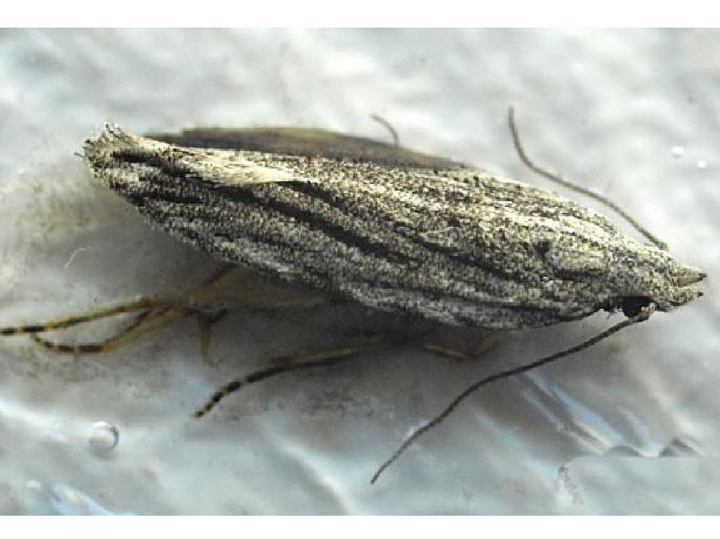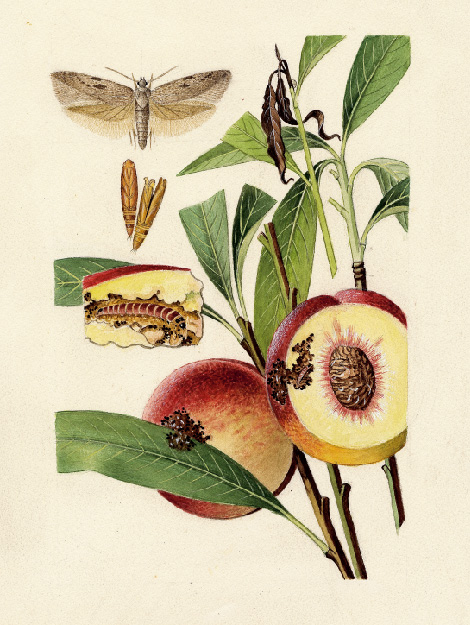Peach twig borer
Anarsia lineatella
Appearance

The moths of the peach moth(Anarsia lineatella) are gray and about 14 mm long. They are characterized by lanceolate forewings with small black dots as well as lighter hindwings.
The larvae (caterpillars) are brown with light pink intersegmental coloration and black head coloration. The intersegmental coloration makes them look like ringed ("zebra caterpillar"). They can grow up to 12 mm long.
Biology
The peach moth belongs to the palp moth family (Gelechiidae).
The activity of the peach moth begins in spring when the overwintering young larvae (caterpillars, second larval stage) move from the protective cocoons in branch forks or bark hiding places to the fresh shoots. They bore into the shoots, feed downward in the pith, destroying several shoots in the process of damage.
For pupation, they prefer to spin themselves into folded leaves. One to two weeks later, the first folding hatch occurs, which can be the case in the Austrian peach-growing region from about mid-May. The moths are crepuscular and nocturnal. The peak of the flight phase of the first generation is around June.
The females of this generation usually lay their eggs singly on the underside of the leaves. From there, the hatching larvae (caterpillars) move to the fruit to bore in and feed under the fruit skin. If no or only few fruits are present, shoot tips are infested again. Pupation occurs on fruit stalks or between leaves. The females of the following generation, with flight peak about August, lay the eggs partly already on bark places, because the hatching caterpillars form the overwintering generation.
Damage symptoms

Infested shoot tips wilt, dry up and often show a characteristic flag-like appearance. On infested fruit, dark, sunken areas can be seen on the fruit skin, as well as drops of congealed liquid (gum flow) and brown fecal crumbs.
In the fruit just below the skin, the flesh is destroyed, interspersed with feces and putrid; larvae (caterpillars) may be found. Cocoons or pupae may be spotted on the fruit or even spun between leaves.
Due to increased sunlight, which leads to earlier ripening of the fruits, the upper tree sections often show a higher infestation.
The symptoms can be confused with those of the peach moth(Grapholita molesta), for example.
Economic importance
The peach moth can occur as a dangerous pest in peach crops and nurseries (annual grafting) and cause considerable shoot and fruit damage.
In surveys in Austria (cf. Schildberger et al. 2005), fruit infestation by the peach moth on peaches and plums was detected in addition to shoot infestation. The proportion of peach moth larvae detected on peaches was usually higher than that of the peach moth. In plums, on the other hand, only isolated peach moth larvae were found, while plum moth and peach moth were found in greater numbers.
Prevention and control
- Detection of occurrence (monitoring, prevention) as well as to determine treatment dates by traps (e.g. delta traps) to catch the adults using attractants (pheromones).
- Hygiene in the orchard: regular removal and harmless destruction of infested plant material (remove infested shoots and fruits while the larvae are still in them)
- Plant protection products against this pest are listed in the register of plant protection products approved in Austria.
Last updated: 12.07.2022
automatically translated